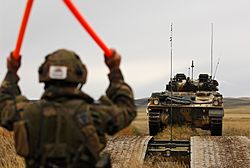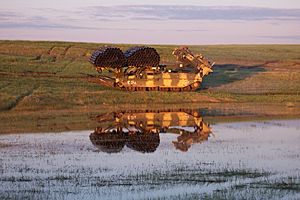British Army Training Unit Suffield facts for kids
Quick facts for kids British Army Training Unit Suffield |
|
|---|---|
| Suffield, Alberta Near Medicine Hat |
|

A soldier guides a Warrior armoured vehicle over a bridge.
|
|
|
Location within Alberta
|
|
| Coordinates | 50°16′24″N 111°10′30″W / 50.27333°N 111.17500°W |
| Type | Training Area |
| Site information | |
| Owner | Ministry of Defence |
| Operator | |
| Site history | |
| In use | 1971–present |
The British Army Training Unit Suffield (BATUS) is a special place where the British Army trains. It is located in Alberta, Canada, at a huge training area called Canadian Forces Base Suffield. BATUS is the British Army's biggest training ground for armoured vehicles like tanks.
Soldiers can practice live firing here. They also use special computer simulations. This allows them to train large groups of soldiers, called "battle groups." The training area is enormous. It is seven times bigger than a similar training area in the UK. This huge space lets the British Army do big exercises that are not possible in the United Kingdom.
Contents
How BATUS Started
Before BATUS, the British Army used a different training area. This area was in Algeria, which was controlled by France. But in 1940, during World War II, Germany took over France. This meant the British lost access to their training facility in Algeria.
The British needed a new place to train. They could not find a suitable large area in the UK. So, Canada and the UK made an agreement. The Suffield area in Canada became available for British scientists to do tests. Both British and Canadian forces used the area for different experiments. After World War II ended, the British left Suffield. The Canadian Defence Research Board then took over the area.
Why a New Training Area Was Needed
In 1969, there was a change in leadership in Libya. This led to the closure of British military bases there. These bases were at El Adem and Tobruk. American bases near Tripoli also closed. This created a big problem for the UK. There were no areas large enough in Europe for the British Army to practice large-scale tank battles.
So, in 1971, the British and Canadian Governments signed a 10-year agreement. This agreement allowed the British Army to train battle groups in the Suffield area. In January 1972, BATUS was officially created. The first live firing exercise happened in July. The 4th Royal Tank Regiment Battle Group took part. The agreement for Suffield was extended in 1981 and again in 1991. In 2006, a new agreement was made. This allowed British forces to train in Canada permanently.
The Future of BATUS
In September 2020, there were reports about tank training at BATUS. Some thought it might stop because the Challenger 2 tanks were getting old. The mayor of a nearby city, Medicine Hat, was worried. He said BATUS has been very important for the local economy since the 1970s. In 2007, it was estimated that BATUS brought about $100 million into the local economy.
In November 2021, more reports suggested the base might close. Some thought training would move to Oman. However, the UK Defence Secretary said this was not true. He said BATUS would see "change" but would not close. The Ministry of Defence also said BATUS would remain "a vital training base for the British Army."
Training Today at BATUS
Winters in Canada are very cold. So, BATUS conducts training from May to October each year. Usually, four to six battle groups train here. Each group exercises for about 24 days. They are helped by permanent and temporary staff from BATUS. There is also a dedicated "enemy" force. This force is usually provided by a different army regiment each year.
Not many soldiers are permanently based at BATUS. In 2019, there were 229 soldiers and 250 children living there. But many more temporary staff come to help. These temporary staff form the Operations Group. They plan and run the complex training exercises. These exercises include live firing and computer simulations. They also support the camp, including logistics and vehicle repair. Soldiers who are permanently posted to BATUS stay for two years. Sometimes, local actors who speak French are hired. This helps soldiers practice working with people who do not speak English.
One major exercise is called "Prairie Fire." It lasts 30 days and happens four times a year. This exercise tries to be as real as possible. It simulates being sent to a warzone, fighting, and then returning home. During the exercise, soldiers fight against fictional "Donovians" in a made-up country called "Atropia."
What Happens in Winter?
During the winter months, the Canadian Forces use the Suffield area. They conduct special Arctic warfare training. Meanwhile, the UK vehicles at BATUS are prepared for the next year's training.
Vehicles and Aircraft at BATUS
About 1,400 soldiers are based at BATUS. They use over 1,000 vehicles. This includes 22 Challenger 2 tanks. There are also 103 Bulldog armoured fighting vehicles. BATUS also has Warrior infantry fighting vehicles. Other equipment includes AS-90 self-propelled artillery. There are also Trojan combat engineering vehicles. These are used for building and clearing obstacles. Titan armoured bridge layers are also present. These vehicles can quickly put down bridges. Finally, Gazelle helicopters from 29 (BATUS) Flight AAC are used.
Who Works at BATUS?
Several units are stationed at BATUS:
- HQ BATUS: This is the main headquarters.
- Combat Ready Training Centre: This group helps make sure soldiers are ready for combat.
- Resident OPFOR: This is the "opposing force" that acts as the enemy. A different armoured regiment or infantry battalion takes on this role each year.
- 29 Flight, Army Air Corps: This is the helicopter unit.
- 105 Logistic Support Squadron, Royal Logistic Corps: This unit handles supplies and transport.
- BATUS REME Workshop: This workshop repairs and maintains all the vehicles and equipment.
See also





